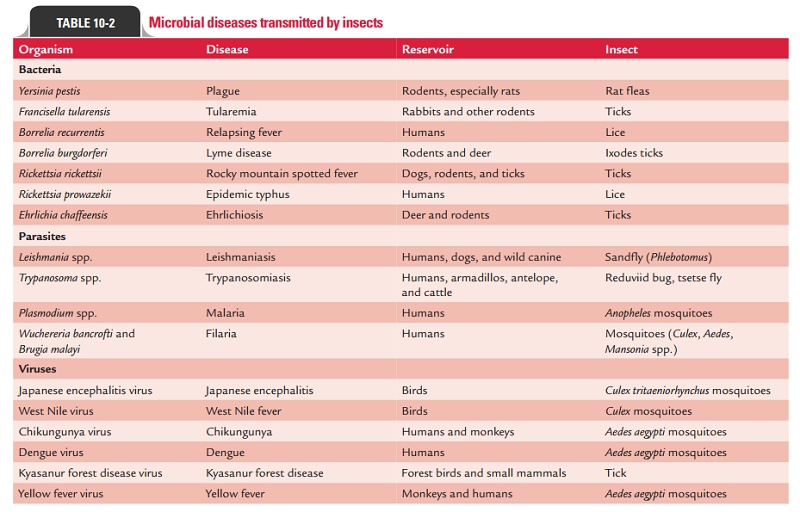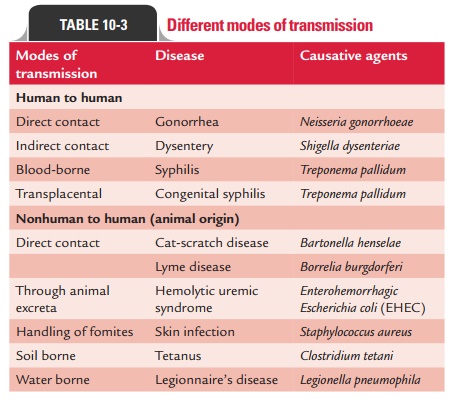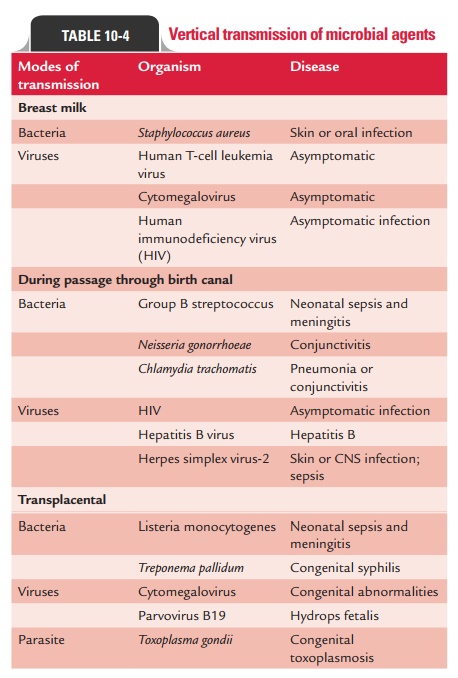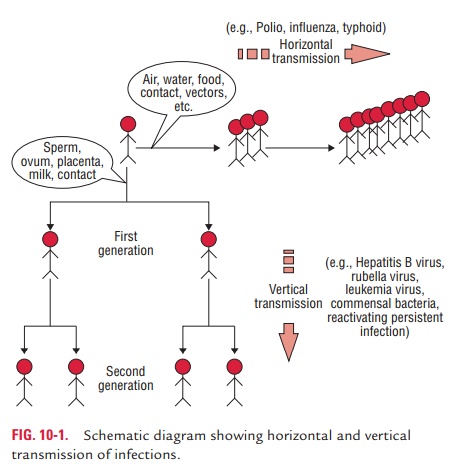Chapter: Microbiology and Immunology: Microbial Pathogenesis
Transmission of Infection - Stages of Pathogenesis of Infections
Transmission of Infection
There are three important components that play an important role in
successful transmission of microbial diseases. These are (a) reservoir, (b)
mode of transmission, and (c) susceptible host.
◗ Reservoir
Reservoirs of microbial infections are human, animal, plant, soil,
or inanimate matter in which organisms usually live, mul-tiply, and cause the
infections with or without overt clinical manifestations. Humans are usually
the common reservoirs of many of the microbial infections. Animals are
reservoirs of zoonotic infections, such as plague (e.g., rats), rabies (e.g.,
dogs), cysticercosis (e.g., pigs), etc.
Sources of infections: The sources of infections may
beendogenous and exogenous:
Endogenous sources: The
source of infection is the normalbacterial flora present in the human body.
These bacteria are usually nonpathogenic but in certain situations become
pathogenic and cause infections at different sites in the same host. For
example, Escherichia coli present as
normal flora of the intestine may cause urinary tract infection in the same
host. Similarly, viridans streptococci present as a part of the normal flora of
the mouth may cause infective endocarditis.
Exogenous sources: The
source of infection is from outsidethe host’s body. Most of the microbial
infections are exoge-nous in nature. The exogenous sources include the
following:
1. Humans: Humans are the most common sources ofinfections caused by
the microorganisms. They may be either patients or carriers. The patient
suffering from an active infec-tion is an important source of infection to
others
A carrier is a person who harbors pathogenic microorgan-isms
without showing any signs and symptoms of disease. Carriers are also important
sources of infections. A carrier may be (a)
healthy carrier, (b) convalescent
carrier, (c) temporary carrier, and (d) chronic carrier.
·
Healthy carrier is the host who harbors the
microorgan-ism without ever suffering from the disease caused by that
microorganism.
·
Convalescent carrier is the host who continues to
harborthe microorganism even after recovering from the clinical disease caused
by the same pathogen.
·
Temporary carrier is the host who harbors the
microorgan-ism up to 6 months after recovering from the disease caused by the
same pathogen.
·
Chronic carrier is the host who harbors the
microorgan-ism for many years after recovering from the clinical disease caused
by the same pathogen.
2. Animals:
Animals
are also important sources of infectionfor humans. The symptomatic as well as
asymptomatic animals can transmit infections to humans. Asymptomatic animals
act as a reservoir of human infections. These are called as reservoirhosts.
Infections transmitted from animals to humans are called zoonotic infections.
The examples of zoonotic infections include bacterial (e.g.,
plague, anthrax, bovine tuberculosis, etc.), viral (e.g., rabies, Japanese
encephalitis, etc.), fungal (e.g., dermatophytic infec-tions), and parasitic
(e.g., toxoplasmosis, cysticercosis, hydatid disease, etc.).
3.Insects: Insects, such as mosquitoes,
ticks, mites, flies,fleas, and lice may transmit a wide variety of
microorganisms to the humans (Table 10-2). The diseases transmitted by the
insects are collectively referred to as arthropod-borne diseases and the
insects transmitting these pathogens are called vec-tors. Insect vectors may
transmit the infection in two ways: mechanical transmission and biological
transmission.

·
Mechanical vectors: Insects (e.g., domestic
flies) carryenteric bacteria (Salmonella
typhi, Shigella spp., etc.)
mechani-cally on their legs, wings, and surface of the body and trans-fer them
to food.
· Biological vectors: These are the vectors in which themicroorganisms multiply or undergo a part of their life cycle before being transmitted to humans. Rat flea and female Anopheles mosquitoes are the examples of biological vectors that transmit plague and malaria, respectively, to humans by biting.
Insects, besides acting as vectors, also act as reservoir hosts
(e.g., ticks in relapsing fever).
4. Food: Food items contaminated with pathogens also act assource of
infection and cause diarrhea, dysentery, food poison-ing, and gastroenteritis.
5. Water: Water contaminated with microorganisms also acts asa source
of infection and transmits water-borne diseases, such as leptospirosis,
cholera, dysentery, hepatitis A infection, etc.
◗ Modes of transmission
Microbial pathogens causing various infectious diseases are
transmitted from one host to another by many ways: (a) con-tact, (b)
inoculation, (c) ingestion, (d) inhalation, and (e) vectors (Table 10-3).

1. Contact: Transmission of
microorganisms from personto person occurs by direct or indirect contact. Transmission bydirect contact occurs
through the acts of touching, kissing, sex,etc. Hence, this mode of
transmission is also known as person-to-person transmission. The diseases
transmitted by direct contact include common cold, staphylococcal infections,
and sexually transmitted infections (e.g., gonorrhea, syphilis, and AIDS,
etc.). The term contagious disease was used earlier for the disease acquired by
direct contact.
Microorganisms can also be transmitted
by indirect con-tact through inanimate objects, such as clothings,
handker-chief, toys, etc., called fomites. The fomites, contaminated
by microbial pathogens, act as a vehicle for their transmission. Influenza,
tuberculosis, and certain superficial fungal infec-tions are examples of
diseases transmitted by fomites.
2. Inoculation: Infections can be transmitted
by inoculationof microorganisms directly into tissues of the host. For example,
tetanus is transmitted by direct inoculation of Clostridium tetani spores present in soil to the injured tissuesin
the host. These spores then germinate to vegetative forms of bacteria and
migrate along the neural tissues to cause teta-nus. Similarly, rabid dogs
through their act of biting inoc-ulate rabies virus directly to host tissue and
cause rabies in humans.
Iatrogenic infection occurs following the use of unsterilesyringes
and equipment in a hospital. Hepatitis B and C and HIV infections are the
examples of iatrogenic infections caused by use of contaminated syringes and
that of contaminated blood and blood products.
3.Ingestion: Ingestion of water and food
contaminatedwith microorganisms can transmit a wide variety of micro-bial
infections. For example, food poisoning caused by Bacillus cereus is transmitted by rice contaminated with bac-terial
spores that survive boiling. If the rice is cooled and reheated, the spores of
the bacteria may germinate to the bacteria that produce a heat-stable toxin
that induces vomit-ing. Cholera, typhoid, food poisoning, hepatitis A,
poliomy-elitis, and many parasitic infections are the other examples of
diseases transmitted by ingestion of contaminated food and water.
4.Inhalation: Infections are transmitted by
inhalation ofdroplet nuclei that are discharged into the air by coughing,
sneezing, or talking. Respiratory pathogens are shed into the environment by
patients in secretions from the nose or throat during coughing, sneezing, or
talking. Small droplets (less than 0.1 mm in diameter) become airborne as
minute particles or droplet nuclei (1–10 mm in diameter), while large droplets fall down
to the ground. Infections are transmitted by inhalation of these droplet nuclei
containing respiratory pathogen, which remain suspended in air for a long
period of time.
Measles, influenza, whooping cough, tuberculosis, aspergil-losis,
etc. are few examples of infectious diseases acquired by inhalation.
5.Vectors: Mosquitoes, flies, fleas,
ticks, mite, and lice are thevectors that transmit many diseases as mentioned
earlier.
◗ Susceptible host
The infective agent enters the body by four main routes: (a) genital tract, (b) respiratory tract, (c)
gastrointestinal tract, and (d) skin.
The pathogens can be transmitted either as vertical or horizontal transmission.
Vertical transmission: Certain bacteria (Treponema palli-dum), viruses (rubella
and cytomegalovirus), and parasites(Toxoplasma
gondii) can be transferred from mother to fetus by a process called
vertical transmission (Table 10-4). The organ-isms can be transmitted
vertically by three ways:
a)
Across the placenta,
b)
Within birth canal during birth, and
c)
Through breast milk.

Table 10-4 summarizes a list of diseases transmitted vertically.
Horizontal transmission: Unlike vertical transmission,
hori-zontal transmission occurs from person to person and is not from mother to
offspring (Fig. 10-1).

Related Topics